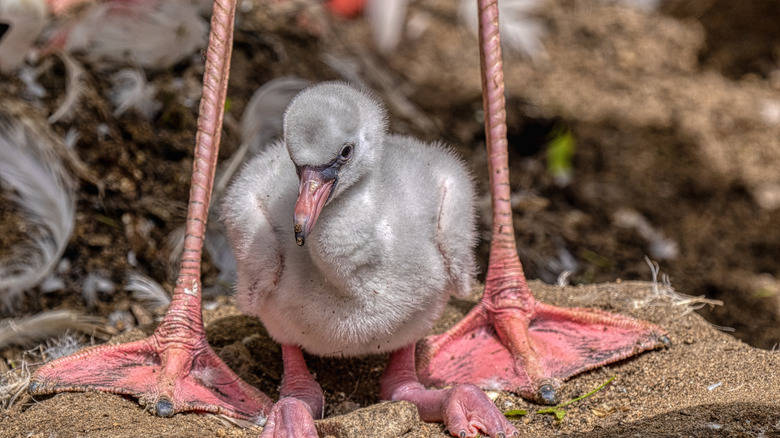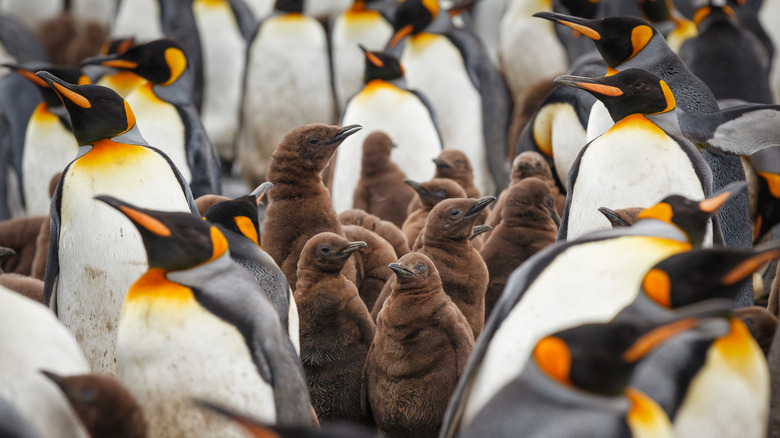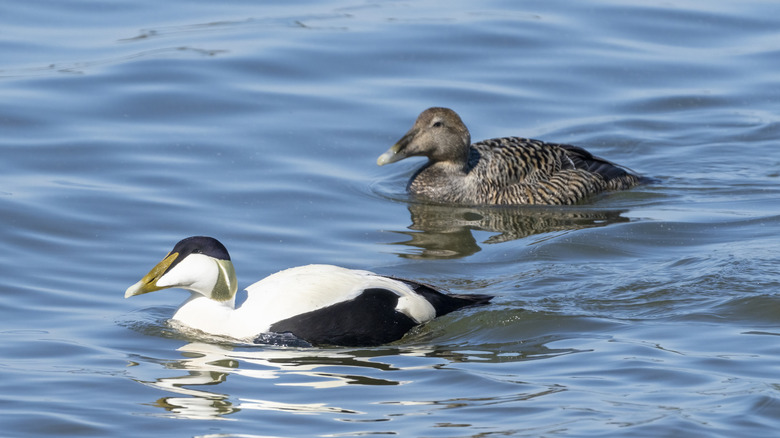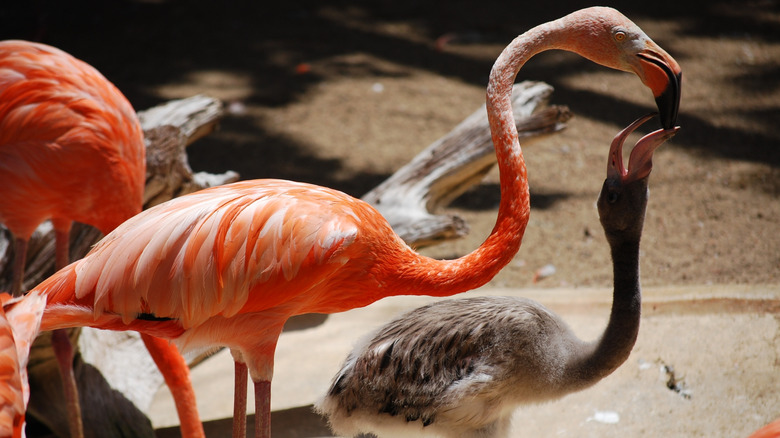The Best Bird Mothers In The Animal Kingdom Will Have You 'Aww'ing All Day
Motherhood takes many forms across the animal kingdom, from snakes that lay their eggs and let their offspring fend for themselves to African elephant calves that spend the first four to six years under a mother's watchful eye. Looking strictly at our feathered friends, there is variation to be found as well, with Cornell Lab's Clement Checklist recognizing 11,145 species of birds. That makes for many mothers, like their patient dog-mom counterparts, raising adorable baby chicks worldwide in various environments.
All birds will raise their little hatchlings the best they can, given their environment and circumstances. However, considering what humans value in the mother-child relationship, some birds can be regarded as the best by exhibiting traits that make that bond so cherished. These protective mothers go above and beyond to ensure their little ones have a chance at success once they leave the nest. At the same time, the dedication and love of raising a chick will have you "aww"ing at their unwavering commitment and the bonds formed from hatching to that first step out of the nest.
King penguins go to great lengths to protect their young
Penguins have come to be revered as amazing mothers (and fathers). This trait can be attributed to the popular 2005 documentary "March of the Penguins," which showcased the birds' persistence in harsh climates, including the lengths they go to protect their young. The remarkable journey chronicled in the documentary has led to admiration and online homage in the form of adorably funny penguin memes. The title of best mother of the animal kingdom is deserved, as the penguin's plight goes above and beyond when compared to other seabirds.
Penguins, particularly the king penguin, spend a lot of time raising their chicks. This period can last up to fifteen months and can be divided into two stages. The first is around 37 days, where the chicks are strictly guarded under the protection of their parents. During this time, the mother is the primary watcher, but she will leave to forage for food and let dad take turns watching over the newborn. Afterward, in stage two, the cute little fluffballs form communities called creches under the watchful eye of the larger community of parents. King penguins will spend a summer and two winters ensuring their offspring are safe and well-fed before letting them take their first waddles towards independence.
One remarkable story highlights the bald eagle as a great mother
Jackie and Shadow, the recent online sensation, have had social media abuzz with the remarkable story of their quest to become parents. The Big Bear Lake duo in California had a hard road to parenthood, with a few failed attempts at hatching eggs before finally welcoming three eaglets to their nest. Since then, the public has been watching via a 24-hour camera set-up to monitor the family and capture moments highlighting the family's challenges and triumphs, with a particular love for Jackie as a dedicated mother. Jackie has stood guard against predators and has shown the bald eagle's exceptional commitment to keeping eggs covered and warm during harsh winter weather.
Jackie and Shadow are not wholly unique in their parenting. Bald eagles attentively watch over their young for 10 to 12 weeks after they hatch and before they can fledge. During this period, the mother will seldom leave the nest other than to stretch her wings and relieve herself. The father becomes a dedicated protector and food gatherer, sharing feeding and protection duties when possible. With dedication, the two parents can raise one to three chicks to carry on the legacy of the majestic bald eagle and, hopefully, go on to raise their own families.
Eider ducks will sacrifice their warmth and health for their young
Although the eider expresses many of the same behaviors as many other duck species, it faces unique challenges regarding parenthood due to the harsh climates in the northern hemisphere. Notably, to help keep its nest warm, a mother eider will pluck the down feathers from her chest to ensure proper insulation for her young during the 24-to-26-day incubation period. During incubation, the mother eider will not eat and can lose almost 45% of her body mass — certainly some serious dedication.
They say it takes a village to raise a family, and the eider ducks embody this sentiment. A mother will lead her chicks to water when ready to leave the nest, joining other families to make a large group of up to 150 ducklings. A true gathering of a community, non-breeding females also aid in raising and protecting the young during this time. The group will stick together until the duckling is ready to prove itself independent, at around 55 to 60 days. A dedicated mother and a great community undoubtedly make the eider ducks "aww"-inducing bird families.
Greater flamingos work together to raise their young
The greater flamingo combines many traits of the best mother birds while going above and beyond in other ways. Notably, greater flamingos form small communities of 15 to 50 pairs and synchronize their breeding to ensure all chicks are raised together. This long-term community is built around monogamy, as many flamingos form lifelong pairings and rely on those parental and communal bonds to raise their young.
Each pair lays a single egg, which incubates for 27 to 31 days. The little flamingo spends additional time under their mother to help strengthen their bodies before exploring outside their nest. A flamingo's nest requires a lot of hard work from both parents. Using mud, a pair of flamingos gather enough material to create a large, stable structure that stays safe and secure in shallow waters; these nests can be up to a foot tall.
Once they hatch, parents must feed the chicks by mouth until their beaks grow from the straight ones they are born with into the curved ones of adults. Until they are old enough to function independently, the chick relies on its parents for food and the tight-knit community for protection and support. From the penguin to the flamingo, nature reminds us of the resilience and care required to raise a family; we can learn a lot from these remarkable feathered mothers.




